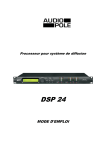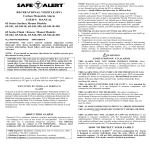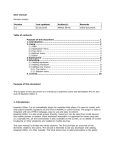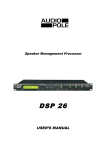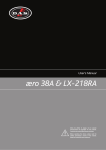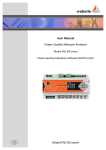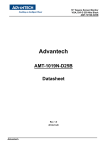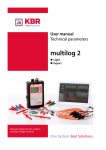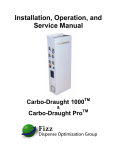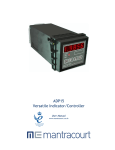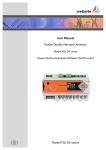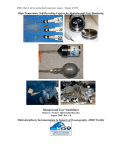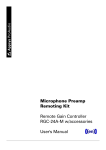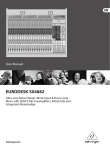Download Phase alignment between subwoofers and mid
Transcript
Technical Report PHASE ALIGNMENT BETWEEN SUBWOOFERS AND MID-HIGH CABINETS Introduction FFT based field measurement systems have made it possible for us to do phase alignment at fixed installations as well as at live events, where every venue demands a different approach. This is particularly important these days, since mid-high boxes are often flown and subwoofers remain on the ground, meaning that phase differences at the listener location can be very significant. Given the interest in the subject, and the remarkable improvement it can bring to a system, it seems like a good idea to write an article that describes the measurement process step by step. Before doing that, however, let’s go over the concept of phase. Polarity and Phase Polarity only has two discreet values: positive and negative. Polarity does not change with frequency, and may be accidentally inverted when the speaker cables are connected the wrong way, or when a signal cable is repaired and pins 2 and 3 get inverted, or when one of the bands has its polarity changed on the signal processor by mistake. Other times polarity is purposely reversed, such as when a passive crossover filter is used. Phase may have any value in degrees: values are continuous. To find out what the phase response is for a given speaker, we need to measure it. Throughout this article we’ll see measurements performed using SATLive. Phase curves are shown on the bottom part of the image, while the magnitude frequency response will be at the top of the image. Figure 1 one shows a typical subwoofer phase response in blue, with polarity reversal in green. A 180º shift can be clearly observed at all frequencies. Engineering Department 1 Technical Report Fig 1. Comparison of two phase curves, one with opposite polarity. Running a phase measurement on our systems, and storing it for reference, can be useful for checking for correct polarity after maintenance. Since we are only looking for a comparison, any measurement position that can be repeated easily would suffice. For instance, the microphone can be placed directly in front of the speaker, in its centre, very close to the grille. This provides an easily repeatable measurement position and a clean measurement with no contamination from the environment. What makes phase vary? a) Any variation on a system’s magnitude frequency response will have an effect on the phase response. For instance, the phase curve changes when equalization is added. Figure 2 shows the result of adding a bell-type filter centered at 5.04 Khz, with a width of 0.42 Oct and +10dB gain, to the high frequency band on a processor. Phase rises just before the centre frequency and falls just after it. Engineering Department 2 Technical Report Fig. 2. The green trace shows the effect of a bell-type filter on the phase response. Since equalization affects the phase response, outputs should never be EQed once phase alignment has been done, especially around crossover frequencies. Otherwise we would modify the phase of the output being equalized, hence affecting the relationship between phase responses, which is what we are trying to adjust for when adding delays. EQing the input (on the processor itself or on a graphic equalizer or the mixing desk) will not affect phase alignment, since it happens before the crossover. b) Adding delay to a band, or physically displacing it backwards (such as moving a subwoofer away from the measurement microphone) will have the same effect on the phase response. Figure 3 shows the effect on the phase response of adding delay to the mid-high cabinet. The blue trace corresponds to the mid-highs before being delayed, while the green one shows the result of adding 0.0313ms (∆τφ= 0.0313ms). The phase increase (∆φº) can be calculated from the equation ∆φº = 360f * ∆τφ. It can be clearly seen that the change in phase varies with frequency and as a function of the amount of delay added. Since the delay is added to the whole band, the phase increase will be larger the higher the frequency, i.e. the lower the period. Figure 3 shows that the phase difference between traces becomes larger as the frequency increases. Engineering Department 3 Technical Report Fig. 3. When adding delay to a band, the effect on the phase response is larger for higher frequencies, where the added delay represents a bigger percentage of the period compared to low frequencies. The same thing happens to subwoofers. The blue trace in Figure 4 shows the phase response for a double 18” subwoofer, while the green trace shows the effect of physically moving it back 1.7m (about 5.6 ft). The delay (physical in this case) increases the slope of the phase curve in the pass band. Again, the effect increases with frequency. Engineering Department 4 Technical Report Fig 4. Moving a source behind its initial placement has the same effect as adding a delay. The blue trace corresponds to the initial position, while the green one shows the phase curve of a subwoofer that has been shifted 1.7m behind. c) If the type of crossover filter is changed, the phase will change too, since the different filter types, and their correspondingly different slopes, will have their own effect on phase. Figure 5 shows the responses of a Linkwitz-Riley 24dB/oct high-pass filter as well as a Bessel one with identical cut-off frequency. Engineering Department 5 Technical Report Fig. 5. If the filter type is changed on a processor, the magnitude as well as the phase frequency response changes. The figure above shows the effect of an L-R 24dB/oct high-pass filter (blue trace) and a Bessel 24dB/oct one, both with the same cut-off frequency (1410 Hz). What do we mean by phase alignment? What we are after is a sum of the subwoofers and the mid-highs that result in maximum achievable sound pressure level, i.e. no cancellation (partial or total) in the crossover region. To accomplish that goal we need to get the phase traces to overlap. Sometimes we will reach complete overlap, whilst other times we will not, as we shall see in the examples, but there will normally be an improvement as compared to a system that has not been phase aligned. A final magnitude frequency response measurement will always be required after delays have been applied, so improvements can be checked against the curve for the system without delays. When complete overlapping is not reached with the use of delay alone, we can improve upon the results if our processor provides phase filters. To simplify the understanding of this technique, however, our examples will only use delay. Coherence Curve The coherence curve that Fast Fourier Transform based measurement systems provides indicates the probability that the measurement is reliable. It’s very common to find a coherence curve (ranging from 0 to 1, or from 0% to 100%, depending on the Engineering Department 6 Technical Report measurement system) with low values in part of the spectrum. We should not trust the magnitude or phase frequency responses for those bands for which our measurement system shows low coherence. There are two main reasons for poor coherence: 1) Reference signal is badly synchronised with the measured signal. We can test for this easily if we initiate a measurement without having first synchronised the measurement signal using the “Delay Finder” on SATLive or the equivalent function in other systems. In this case it will be seen that coherence for the high frequencies is very low, as seen in Figure 6. Fig. 6. SATLive’s coherence scale can be seen on the right-hand side, ranging from 0 to 1. This curve’s coherence trace has been stored and loaded with the Trace Manager utility, and is shown as a thinner blue trace. 2) Reflections. These will cause coherence in some frequency bands to be low. We should not trust measurements on those bands. If we are interested in measuring a part of the spectrum that has poor coherence, we can change the microphone location. Engineering Department 7 Technical Report When it comes to adjusting phase, we should check the coherence in order to know which parts of the measurement are reliable and which ones are contaminated by reflections, reverberation, etc. Example 1. “Scaled down measurements: the subwoofer and the migh-high box share a frequency band” Before trying to do these adjustments for the first time in a real-life situation, where one may not always have enough time and where conditions are far from ideal, scaled down measurements can be handy to get some practice with the procedure. We’ll assume that you already know how to take transfer function measurements with the measurement system you are using, and that the equipment used is adequate. To synchronise the reference signal to the measurement signal, we need to measure the system’s impulse response, which is better obtained from the high frequency band, and therefore we’ll always use the mid-high units for synchronisation. There will be times when we’ll need to shift the subwoofers backwards by adding delay, and times when we will need to move them “forward” with “negative delay”. Since such thing does not exist, we’ll add an initial time delay that is the same for all bands, so that we will be able to add or subtract delay from the subwoofers’ initial delay time. Once the system has been adjusted, we’ll get rid of excess delay, as will be seen in the examples. Let’s now run a scaled down measurement of an 18” subwoofer and a mid-high unit. Subwoofer cut-off frequencies for the real system will be: HPF LR24dB/Oct, 30Hz LPF LR24dB/Oct, 85Hz Cut-off frequencies for the real mid-high unit will be: HPF LR24dB/Oct, 50Hz LPF LR24dB/Oct, 20KHz We’ll use two 4” speakers to get some practice with the phase adjustment procedure. For our 4” to behave acoustically like our real, full scale systems, we will need to scale the crossover frequencies up. To do that we’ll multiply the real system cut-off frequencies by the ratio of the real system to our scaled down box, i.e., we will multiply the cut-off frequencies by 18”/4” = 4.5 Therefore the cut-off frequencies for the scaled down measurements, which will be entered in the processor for the 4” system, will be as follows: Engineering Department 8 Technical Report Cut-off frequencies for the scaled down subwoofer system will be: HPF LR24dB/Oct, 30Hz x 4.5 = 135Hz LPF LR24dB/Oct, 85Hz x 4.5 = 382Hz The cut-off frequencies for the scaled down mid-high system will be: HPF LR24dB/Oct, 50Hz x 4.5 = 225Hz LPF LR24dB/Oct, 20KHz We’ll leave the low pass filter for the mid-high box at 20 kHz. Otherwise we would be in the ultrasonic range. For these measurements we used a DAS Arco 4 enclosure as the subwoofer, lying on its side. The box used as a mid-high, also a DAS Arco 4, is placed somewhat higher up, and some 15cm (6”) behind the box being used as a subwoofer, as shown in Figure 7. The microphone is placed on the ground, at 90cm (3 feet) from the simulated subwoofer. Fig 7. Side view set-up for the scaled down measurements used for examples 1 and 2. In order to notice more easily the difference between aligning the phases or not aligning them, it is recommended to set the acoustic levels of the mid-high and the subwoofer the same in the band being shared, 225Hz to 382Hz in our exercise. The procedure is as follows: 1) Enter 20 ms as the delay time for each of the outputs in the processor (This is an arbitrary value; a different delay time can be used). 2) Let’s first work just with the mid-high. We’ll use the “Delay Finder” utility to add the required delay to the channel with the reference signal, i.e., to synchronise the reference signal to the measured signal. (See the user’s manual for SATlive or your analysis software for more information). Engineering Department 9 Technical Report 3) Measure the magnitude frequency response for the complete system before doing phase adjustments. At worst, we will see significant cancellation in the frequency range being shared by both enclosures. The measurement can be seen in Figure 8. Fig 8. This is the magnitude frequency response curve we are trying to improve on. A cancellation can be seen around 400Hz, and therefore within the frequency band being reproduced by both boxes. 4) Mute the subwoofer output, and unmute the mid-high output in the processor. 5) Measure the mid-highs and save the curve. In our example, the curve in Figure 9 is obtained. Engineering Department 10 Technical Report Fig. 9. Magnitude and phase frequency response for the mid-highs. 6) Mute the mid-highs and unmute the subwoofer output. 7) Do not use the “Delay Finder” again!!! (i.e., do not synchronise the reference signal to the measured signal again) Remember that we are comparing phase on both outputs, i.e. we are measuring the difference in time arrival between the two signals as a function of frequency. Therefore the synchronisation delay for the reference signal should not be changed on the measurement software again. Keep in mind that we took the mid-high box as our timing reference because it is the signal from which the best impulse response can be obtained. 8) Measure the subwoofer and compare the phase curve with that of the mid-high box. The result can be seen in Figure 10. Engineering Department 11 Technical Report Fig 10. Capture shows the difference in phase between the subwoofer and the top box for the frequency band being shared (200Hz to 400Hz). This explains the cancellation seen near 400Hz, and the fact that the level in the rest of this shared band does not increase significantly. 9) Add or subtract delay from the subwoofer output until the two phase curves overlap around the crossover frequency. Do not forget to save the curves. The curve with the steepest slope of the two is the one with the most delay. Therefore, it seems clear in this case that we will have to subtract delay from the green curve, i.e. the subwoofer output. We’ll be able to do this because we initially added a delay of 20ms to the two outputs. Remove some of the delay from the subwoofer output and the green curve will loose slope and shift upwards, and the two phase traces will overlap within a fairly wide band. Engineering Department 12 Technical Report Fig. 11. Top box and subwoofer responses with phase adjustment. It can be seen that phase overlaps in the shared frequency band, which means they will be summing perfectly in phase. The delay on the subwoofer output ended up at 18.666ms. From 150Hz to 400Hz the two curves overlap, i.e. they are in phase within the entire band they share. Therefore, if we compare two phase curves and we want to minimize the difference in phase between them, we need to remember the following: if a curve has a steeper slope than the other, it’s arriving late and we need to take away delay. If a curve has a gentler slope than the other, it’s arriving early and we need to add delay. Keep in mind that, in our example, the subwoofer was physically forward with respect to the top box, so we could have mistakenly assumed it was the subwoofer that needed delaying. Do not forget that filters have an effect on phase, and therefore we cannot predict if we need to add or remove delay until we see the measurements. Let’s see what would have happened if we had increased the delay time to the subwoofer instead of reducing it. On Figure 12 delay has been added to the subwoofer output until the most overlap was obtained. The subwoofer delay ended up as 22.276ms. Phase overlaps in the 250-300 region, which is very little. Below 250Hz the blue phase trace is below the green one, whereas above 300Hz the green curve is below the blue one; i.e. there’s phase difference between them. Engineering Department 13 Technical Report Fig. 12. In this specific case, delaying the subwoofer does not make the phase traces overlap for the entire band. 10) Measure the system frequency response and compare it to the initial measurement. If phase has been correctly adjusted, subwoofers and mid-highs will sum in phase and this will be reflected on the magnitude frequency response. Figure 13 compares the system combination without adjustment (red trace), with 22.2766ms delay on the subwoofer (green trace) and with 18.666ms (blue trace). Engineering Department 14 Technical Report Fig 13. In this particular case, the subwoofer and the mid-high box sum optimally when we take away delay from the subwoofer. It can be clearly seen that the best sum occurs for the 18.666ms subwoofer delay. 11) Take the lowest delay value and subtract it from the subwoofer and mid-high so that at least one of the outputs has a delay time of 0ms. At this time there’s a delay of 20ms on the mid-high and 18.666ms on the subwoofer. Since we had added 20ms just as an arbitrary amount to be able to add or subtract from that as needed, once the adjustments have been made we no longer need that excess delay: subtract the lowest delay time from the two outputs so that one of them has 0ms. In our example the mid-high output will end up with 20ms – 18.666ms = 1.334ms. The subwoofer output will have 18.666ms – 18.666ms = 0ms. Example 2. “Scaled down measurements: the subwoofer and the migh-high box crossed-over at the same frequency” Subwoofer crossover frequencies for the real system will be: HPF LR24dB/Oct, 30Hz Engineering Department 15 Technical Report LPF LR24dB/Oct, 85Hz Crossover frequencies for the real mid-high unit will be: HPF LR24dB/Oct, 85Hz LPF LR24dB/Oct, 20KHz Crossover frequencies for the scaled down subwoofer system will be: HPF LR24dB/Oct, 30Hz x 4.5 = 135Hz LPF LR24dB/Oct, 85Hz x 4.5 = 382Hz The crossover frequencies for the scaled down mid-high system will be: HPF LR24dB/Oct, 50Hz x 4.5 = 225Hz LPF LR24dB/Oct, 20KHz Place the boxes as for example 1 and follow the same procedure. 1) Enter 20 ms as the delay time for each of the outputs in the processor (a different delay time can be used). 2) Let’s first work just with the mid-high. We’ll use the “Delay Finder” utility to add the required delay to the channel with the reference signal, i.e., to synchronise the reference signal to the measured signal. (See the user’s manual for SATlive or your analysis software for more information). 3) Measure the magnitude frequency response for the complete system before doing phase adjustments. At worst, we will see significant cancellation in the frequency range being shared by both enclosures. Engineering Department 16 Technical Report Fig 14. This is the magnitude frequency response that needs to be improved. 4) Mute the subwoofer output, and unmute the mid-high output in the processor. 5) Measure the mid-highs and save the curve. In our example, the curve in Figure 15 is obtained. Engineering Department 17 Technical Report Fig. 15. Magnitude and phase response for the mid-high box. 6) Mute the mid-highs and unmute the subwoofer output. 7) Do not use “Delay Finder” again!!! (i.e. do not synchronise the reference signal to the measured signal again) Remember that we are comparing phase on both outputs, i.e. we are measuring the difference in time arrival between the two signals as a function of frequency. Therefore the synchronisation delay for the reference signal should not be changed on the measurement software again. Keep in mind that we chose the mid-high box as our timing reference because it is the signal from which the best impulse response can be obtained. 8) Measure the subwoofer and compare the phase curve with that of the mid-high box. The result can be seen in Figure 16. Engineering Department 18 Technical Report Fig 16. Phase can be seen to be different at the crossover region, so it is clear that the sum between subwoofer and mid-high can be improved upon. 9) Add or subtract delay from the subwoofer output until the two phase curves overlap around the crossover frequency. Do not forget to save the curves. It is not very obvious in this example whether the subwoofer needs delay to be added or subtracted. Let’s try both and see which one works best. Option a) Remove some of the delay from the subwoofer output. The green curve will shift upwards. Engineering Department 19 Technical Report Fig. 17. Mid-high and subwoofer responses once delay time on the latter has been adjusted such that the phase traces cross each other at the acoustical crossover frequency, which is 400Hz in this case. The delay on the subwoofer output ended up at 18.270ms. We have adjusted the delay time until the phase traces cross each other at the acoustical crossover frequency. This way they sum perfectly in phase at that frequency. Above and below that frequency there is phase difference that needs to be evaluated when comparing the different sums for the boxes with the different delay times. Option b) Add delay to the subwoofer output until phase values are the same at the acoustical crossover frequency. Phase matching is better above the crossover frequency than below it. Again, we will evaluate the result on the next step. Engineering Department 20 Technical Report Fig. 18. In this example, when delaying the subwoofer, phase overlaps at the acoustical crossover frequency and above it, but not below it. 10) Measure the system magnitude frequency response again, and compare it to the initial measurement. If phase has been adjusted correctly, the sum of the mid-high and the subwoofer will be better, and the magnitude frequency response will reflect this. Figure 19 compares both boxes without delay (red trace), with 20.848ms delay on the subwoofer (green trace) and with 18.270ms (blue trace). Engineering Department 21 Technical Report Fig 19. Both delay settings improve the magnitude frequency response with respect to initial configuration without delay. It can be clearly seen that the green and blue traces significantly improve the magnitude frequency response. However, there is no significant difference between them. 11) Take the lowest delay value and subtract it from the subwoofer and mid-high so that at least one of the outputs has a delay time of 0ms. Let’s say we pick the blue curve. There’s a delay of 20ms on the mid-high and 18.270ms on the subwoofer. Since we had added 20 ms just as an arbitrary amount to be able to add or subtract from that as needed, once the adjustments have been made we no longer need that excess delay: subtract the lowest delay time from the two outputs so that one of them has 0ms. In our example the mid-high output will end up with 20ms – 18.270ms = 1.73ms. The subwoofer output will have 18.270ms – 18.270ms = 0ms. If we wanted to run the same exercise with speakers of different size, we would just need to find the ratio between the subwoofer we mean to simulate, and the speaker to be used for the measurement. Engineering Department 22 Technical Report Example 3. “Measurements on a real system” When measuring a real PA for live or installed use, only one of the arrays should be measured, and the microphone should be placed approximately halfway between the source and the maximum distance to be covered, assuming reasonable coherence is obtained at that location. When we choose this centre point for phase alignment we make sure that significant phase change will not occur at any other listening position within the audience area (unless we are really close to the array), be it closer or further away from the speakers. Make sure the floor reflection does not create poor coherence at the crossover frequencies. This is a common occurrence when using a microphone stand. In this example we are aligning phase between a DAS Aero 50 line array and some DAS LX218A subwoofers. The level difference between the two will make the shared frequency range narrower or wider. In our example the two systems overlap in the 45Hz to 125Hz range. The DAS LX218A subwoofer is a self-powered system incorporating signal processing (crossover and equalization), but we will use an external processor in order to add delay for alignment to the mid-highs. A common mistake is to filter a self-powered system at the same crossover frequencies used in the equivalent passive system, this way the slope corresponding to the external processor adds to the slope provided by the integrated crossover, so we end up, for instance, with a sort of 48 dB/oct filter instead of a 24 dB/oct one. In our example, no filtering is used at the external processor. Only the filtering that is built into the subwoofer is used. The DAS Aero 50 mid-high is a 3-way line array system. Each of its 3 bands has a factory specified delay time applied on an external processor. The procedure is the same as for the previous examples: 1) Enter 20 ms as the delay time for each of the outputs in the processor (a different delay time can be used). 2) Let’s first work just with the mid-high. We’ll use the “Delay Finder” utility to add the required delay to the channel with the reference signal, i.e., to synchronise the reference signal to the measured signal. (See the user’s manual for SATlive or your analysis software for more information). 3) Measure the frequency response for the complete system before doing phase adjustments. At worst, we will see significant cancellation in the frequency range being shared by both enclosures. Engineering Department 23 Technical Report Fig 20. Shown above is the magnitude frequency response that we are trying to improve on. It will be shown below that the low coherence above 100Hz is due to the different arrival times for the mid-high and the subwoofer, with similar levels. The same effect would be seen with a single source and a reflection. 4) Mute the subwoofer output, and unmute the mid-high output in the processor. 5) Measure the mid-highs and save the curve. In our example, the curve in Figure 21 is obtained. Engineering Department 24 Technical Report Fig. 21. Measurements for the mid-high box. In this case the system, normally complemented with subwoofers, uses a very low crossover frequency. 6) Mute the mid-highs, and unmute the subwoofer output. 7) Do not use “Delay Finder” again!!! (i.e. do not synchronise the reference signal to the measured signal again). Remember that we are comparing phase on both outputs, i.e. we are measuring the difference in time arrival between the two signals as a function of frequency. Therefore the synchronisation delay for the reference signal should not be changed on the measurement software again. Keep in mind that we chose the mid-high box as our timing reference because it is the signal from which the best impulse response can be obtained. 8) Measure the subwoofer, and compare the phase curve with that of the mid-high box. The result can be seen in Figure 22. Engineering Department 25 Technical Report Fig. 22. Phase can be seen to be significantly different between the subwoofers and mid-highs. The Aero 50 and LX218A sub overlap acoustically in the 45Hz to 125Hz region for the level ratio we selected. 9) Add or subtract delay from the subwoofer output until the two phase curves overlap around the crossover frequency, as seen on Figure 23. Do not forget to save the curves. In this example the phase trace for the subwoofer shows a steeper slope at the passband than the mid-high system. It is evident that some delay will need to be removed from the subwoofer until the phase curves overlap as much as possible in the band that they share. When reducing the delay time for the green curve on Figure 22 it will shift upwards, eventually disappearing and appearing again on the lower part of the graph. We need to bear in mind that the phase graph only shows values between +180º and -180º. If a larger range were to be used, the traces would not zigzag as they do here. Engineering Department 26 Technical Report Fig. 23. When lowering the delay time on the subwoofer output, the green trace shifts upwards (and reappears on the lower part of the scale) on the SATLive phase graph, decreasing its slope in the pass band. 10) Measure the system frequency response and compare it with the initial measurement. If phase has been correctly adjusted, subwoofers and mid-highs will sum in phase, and this will be reflected on the magnitude frequency response. Figure 24 compares the system combination before (blue trace) and after (red trace) adjustment. Cancellation and poor coherence that were previously seen around 125 Hz have disappeared. As noted above, low coherence was due to the fact that the same frequency band was arriving at different times, which is equivalent to a reflection of similar SPL. Once the correct amount of delay is added, the shared band from the two systems arrives at the same time and coherence goes back to normal. Engineering Department 27 Technical Report Fig 24. Magnitude frequency response before (blue trace) and after (red trace) phase alignment. 11) Take the lowest delay value and subtract it from the subwoofer and mid-high so that at least one of the outputs has a delay time of 0ms. The DAS Aero 50 mid-high is a 3-way line array system with external amplification. Resulting delay times are as follows: DAS LX218A Subwoofer: 14.458ms DAS Aero 50 Low: 20ms Mid: 25.9167ms High: 26.0104ms What we are really after is the time difference for the outputs to be phase aligned. Therefore, the lowest delay of all bands (14.458ms in this case) needs to be subtracted from each of the bands. Final delay times will thus be: Engineering Department 28 Technical Report DAS LX218A Subwoofer: 0ms DAS Aero 50 Low: 5.542ms Mid: 11.4587ms High: 11.5524ms Once the final delay times have been entered, it is good practice to run the measurement again to check that everything is correct. Before adjusting a real system for the first time, it makes sense to practice this procedure as often as possible and with whatever combination of gear we happen to lay our hands on, until we have mastered the technique. Using scaled down systems will allow us to become familiar with the procedures until we are confident to try larger systems. Joan La Roda. DAS Audio, Engineering Department. Copyright © 2009 Engineering Department 29 Technical Report Engineering Department 30































